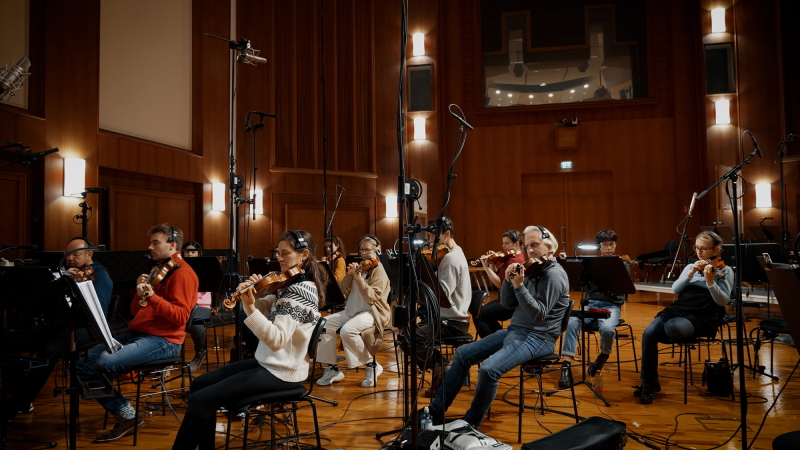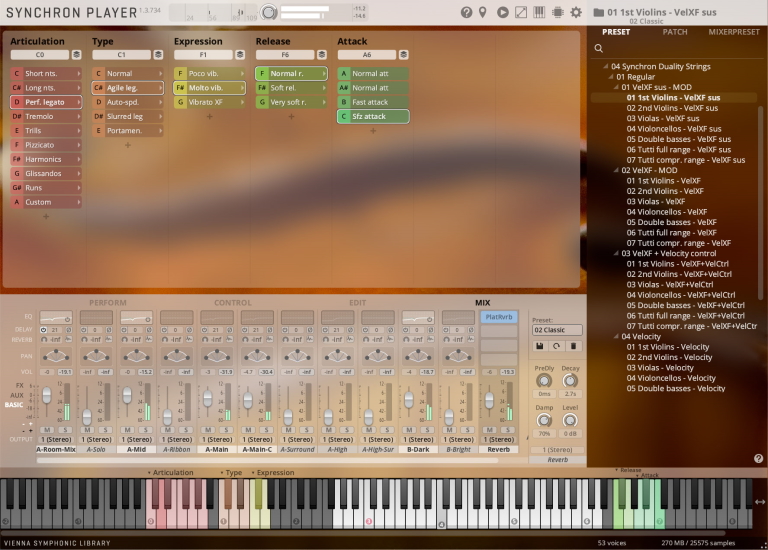VSL Synchron Duality Strings

The Vienna Symphonic Library is pleased to announce the release of Synchron Dualtiy Strings, an innovative library that features two string ensembles that were recorded at once, performing simultaneously in separate rooms at Synchron Stage Vienna. The large ensemble played in the famous main hall, Stage A, delivering a full, more symphonic sound. The smaller ensemble was recorded in the relatively dry Stage B to provide a transparent and clear tonality that adds a certain polish and immediacy when blended with the larger group. The new Collection is currently available at introductory prices of €425 (reg. €595) for the Standard Library and €695 (reg. €960) for the Full Library.
What do you do if you want your string ensemble to sound closer, more direct, maybe crispier? You raise the close-mic faders, which features the section leaders more prominently in your mix. But that pulls unwanted focus toward fewer instruments. You actually want the entire ensemble to be closer, without losing its breadth and depth. So you try layering differently recorded sample libraries, but their performances don’t match, and it’s nearly impossible to create a cohesive result. Wouldn’t it be great to have wet and dry, large and smaller recorded ensembles available in the same player, with recordings of two separate string sections performing in perfect sync?
Enter Synchron Duality Strings. Once again, Vienna Symphonic Library is breaking new ground with a unique library that offers unprecedented possibilities. Synchron Duality Strings comprises two string ensembles that were sampled at once, playing in separate rooms at Synchron Stage Vienna. While the larger ensemble played in the famous main hall, Stage A, the smaller ensemble was recorded in the relatively dry Stage B. Both ensembles performed together, with the conductor on the podium in Stage A also directing the ensemble in Stage B via video monitors.
And that’s where the magic happens. With the musicians’ ability to hear each other from different rooms, all musical aspects of every performance are perfectly in sync, such as volume, timbre, vibrato, note length, and phrasing, for every articulation. Thanks to Synchron Stage Vienna’s unique size, flexibility, and technical capabilities in combination with the wealth of experience from countless sampling and film music recordings, Synchron Duality Strings is truly a unique virtual instrument.
While the mic setup in Stage A delivers the broad, sought-after string ensemble sound featured in countless movies and TV series, the smaller ensemble in Stage B was recorded with two different sets of microphones, offering bright and dark sounding variants. This unique approach gave Synchron Stage Vienna’s chief engineer, Bernd Mazagg, the ability to create mixer presets with unprecedented flexibility and creative options. It also enables users to customize their own string sound organically and effortlessly within the Synchron Player.
Articulations include a wide variety of short notes, long notes, various legato variations (normal, agile, slurred, portamento), espressivo, with various attacks and note releases, plus pizzicato, col legno, tremolo variants, fast repetitions, trills, harmonics, glissandos, legato and détaché runs, and much more. In addition to the Synchron Player’s usual articulation switching capabilities, there’s now a new category of preconfigured patches that allows users to switch articulations using key velocity, e.g., between spiccato and staccato, between different attacks of détachés and long notes, between up and down movements of glissandos and runs, etc.
This extensive collection delivers the best of both worlds – a large ambient string ensemble, and a dry chamber-sized ensemble, with 100% matching performances. Regardless of how they are used, in combination or separately, Synchron Duality Strings delivers a magnificent sound with unprecedented flexibility and countless expressive possibilities, from intimate intensity to passionate power, and everything in between.
The Standard Library and Full Library of Synchron Duality Strings both include the same articulations. The difference lies in the number of provided microphone positions.
 How to resolve AdBlock issue?
How to resolve AdBlock issue? 